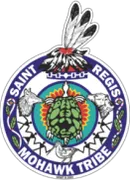AKWESASNE — The Saint Regis Mohawk Tribe’s Environment Division reports that the Forestry Resources Program’s efforts to collect and assess over 200 ash trees for an Emerald Ash Borer Delimitation Survey has concluded. The effort took nearly one year of preparation and planning in collaboration with the United States Forest Service (USFS) and the United States Department of Agriculture’s Animal and Plant Health Inspection Service. The goal of the delimitation survey was to determine the extent and distribution of the Emerald Ash Borer (EAB) to help mitigate the EAB’s impacts on the Akwesasne community.
According to Environment Division Assistant Director Les Benedict, “The Tribe utilized its environmental staff and those deployed through the Northeastern Forest Fire Protection Compact and the Northeastern Interagency Coordination Center to cut ash trees in advance of the debarking effort.” Benedict noted that, “The cutting took place during some of the most extreme winter weather the community has experienced in some time. Severe cold and several snow storms tasked the cutting crews, pushing them to their physical limits of endurance.”
To aide in the process of harvesting ash trees, a tracked vehicle and snowshoes were utilized to lessen some of the burden associated with getting to and from the cutting sites, many of which were a significant distance from plowed roadways. Sub-zero temperatures and high winds contributed to wind chills that brought the efforts to a standstill at one point. With additional manpower enlisted from local and regional agencies in Franklin and St. Lawrence Counties, all of the trees were cut and stockpiled for debarking at the Tribe’s former-Bingo Palace, which now serves as a warehouse on Frogtown Road.
When the 200 ash trees were collected they were further cut into three sections, giving technicians 600 samples to carefully peel and search for EAB larvae. The larvae burrow under the tree’s bark in tunnels, known as galleries that they have make by chewing and feeding. The larvae are several millimeters long and appear worm-like with noticeable segments. They are pale in color with the exception of the head, which is a dark brown color.
“Debarking and searching for the larvae is tedious, deliberate and carefully done to ensure that no larvae are missed,” said Tribal Forestry Resource Program Technician Angello Johnson, who has become accustomed to working with ash trees as a Mohawk basketmaker. Johnson added, “It takes a trained eye to see the larvae and skilled hands to use a draw knife to shave and cut back enough material without damaging the larvae.”
Debarking efforts concluded on Enniskó:wa/March 1, 2019; with all Emerald Ash Borer larvae recorded by tree number and tabulated for analysis by Forest Entomologist Nathan (Nate) Siegert, Ph.D., USFS. Although the debarking was conducted indoors, it was often drafty and cold work. Forestry Resource Program staffers Wayne Samphier and Johnson provided lunch and kept morale high. There was lots of interaction, story-telling and sharing of experiences amongst those who participated in the effort; with the high points and areas for possible improvement discussed during the last day’s debriefing.
Over the past few weeks, Siegert analyzed the collected data and worked with his Geographic Information System Support Services to create a map that portrays the extent and severity of EAB infestation in Akwesasne, which includes the following findings:
- The delimitation survey was successful at identifying several low-density EAB infestations at Akwesasne that annual trapping efforts were not capable of achieving.
- The assessment indicates the infestations are in the early stages, with no old galleries being present.
- The infestation appears to be progressing from the Northwest corner of Akwesasne, with several outlier populations identified farther east.
- The assessment will provide valuable information used to develop management recommendations for the Tribe’s forest resources.
The Tribe’s Environment Division reports that there is still a lot of work to do and the community will be kept up to date about ongoing efforts, with a community presentation planned for this summer. In the meantime, they are continuing to evaluate the project results and formulating strategies to better manage the EAB and ash resources.
GROUP PHOTO CAPTION: The Saint Regis Mohawk Tribe’s Forestry Resources Program announced the conclusion of a year-long study that collected and analyzed 200 ash trees in Akwesasne for the Emerald Ash Borer. Joining in the project were SRMT environment staff and partnering agencies US Forest Service and USDA’s Animal and Plant Health Inspection Service that included: (from left) Tom Colarusso, Greg Bjork, Joe Bither, Elizabeth Spinney, Jevonnah Foster, John Payton, Les Benedict, (behind) Bill Davidson, Nate Siegert, Angello Johnson, Wayne Samphier, and Matt Nolan
FOR MORE INFORMATION:
Related to this project is an upcoming workshop, “Towards Preservation of a Cultural Keystone Species: Assessing the Future of Black Ash Following Emerald Ash Borer Invasion.” The workshop will be held on May 7-8, 2019 at the Hilton–Lake Champlain in Burlington, Vermont, and is sponsored by the United States Forest Service, United States Department of Agriculture’s Animal and Plant Health Inspection Service, Northeast Climate Adaptation Science Center, and University of Vermont. Anyone interested in attending can contact Les Benedict for more information by calling (518) 358-5937. For additional details, including hotel information and registration link, please visit: http://go.uvm.edu/ash-colloquium.
#####

